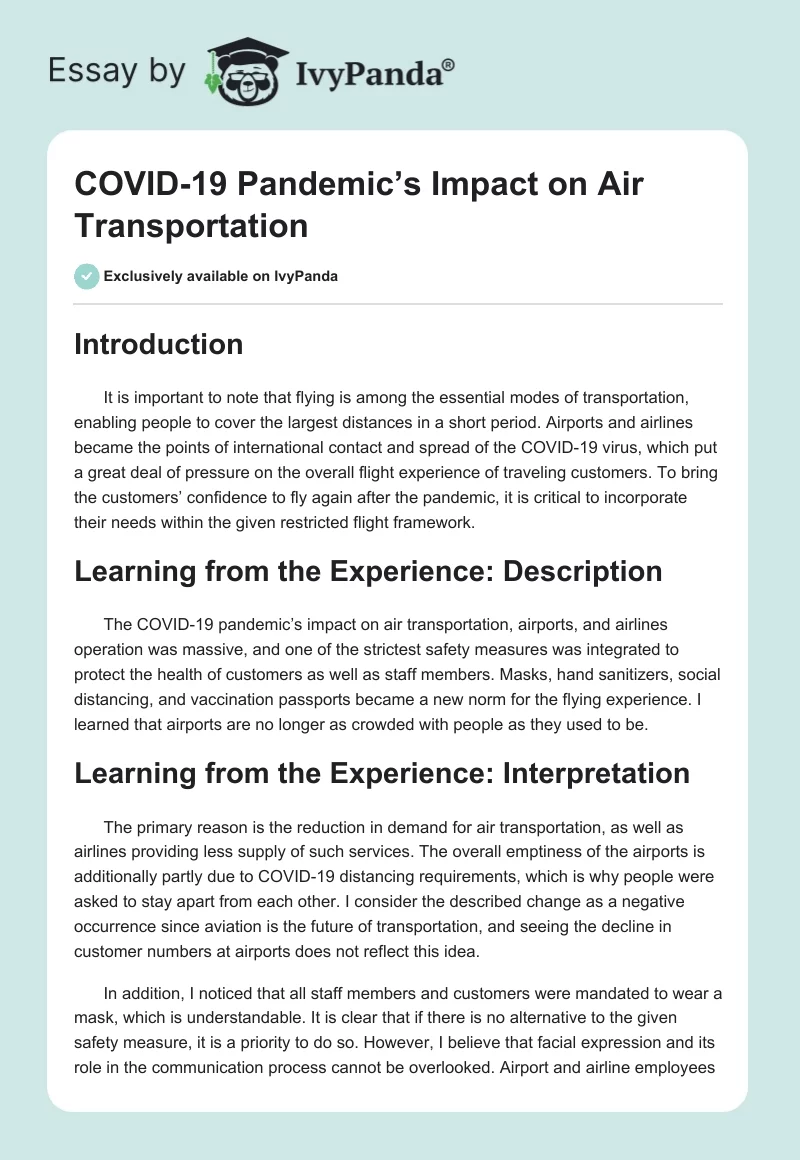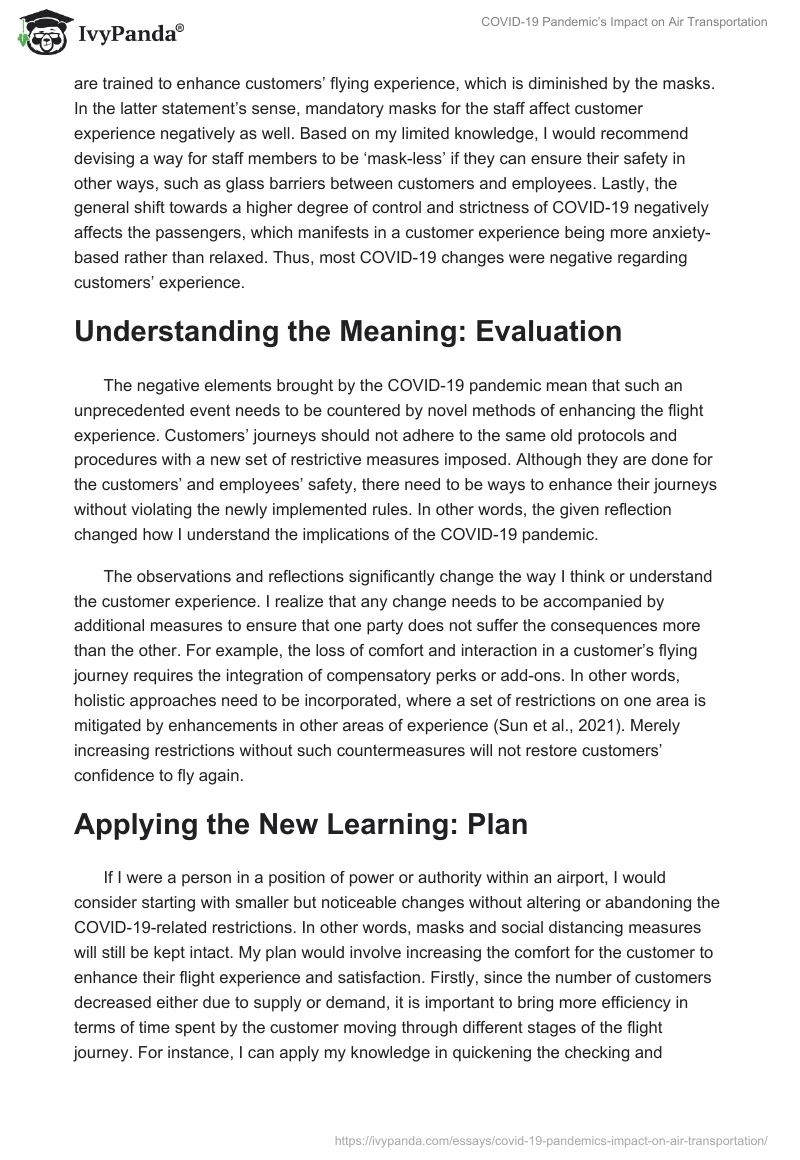Introduction
It is important to note that flying is among the essential modes of transportation, enabling people to cover the largest distances in a short period. Airports and airlines became the points of international contact and spread of the COVID-19 virus, which put a great deal of pressure on the overall flight experience of traveling customers. To bring the customers’ confidence to fly again after the pandemic, it is critical to incorporate their needs within the given restricted flight framework.
Learning from the Experience: Description
The COVID-19 pandemic’s impact on air transportation, airports, and airlines operation was massive, and one of the strictest safety measures was integrated to protect the health of customers as well as staff members. Masks, hand sanitizers, social distancing, and vaccination passports became a new norm for the flying experience. I learned that airports are no longer as crowded with people as they used to be.
Learning from the Experience: Interpretation
The primary reason is the reduction in demand for air transportation, as well as airlines providing less supply of such services. The overall emptiness of the airports is additionally partly due to COVID-19 distancing requirements, which is why people were asked to stay apart from each other. I consider the described change as a negative occurrence since aviation is the future of transportation, and seeing the decline in customer numbers at airports does not reflect this idea.
In addition, I noticed that all staff members and customers were mandated to wear a mask, which is understandable. It is clear that if there is no alternative to the given safety measure, it is a priority to do so. However, I believe that facial expression and its role in the communication process cannot be overlooked. Airport and airline employees are trained to enhance customers’ flying experience, which is diminished by the masks. In the latter statement’s sense, mandatory masks for the staff affect customer experience negatively as well. Based on my limited knowledge, I would recommend devising a way for staff members to be ‘mask-less’ if they can ensure their safety in other ways, such as glass barriers between customers and employees. Lastly, the general shift towards a higher degree of control and strictness of COVID-19 negatively affects the passengers, which manifests in a customer experience being more anxiety-based rather than relaxed. Thus, most COVID-19 changes were negative regarding customers’ experience.
Understanding the Meaning: Evaluation
The negative elements brought by the COVID-19 pandemic mean that such an unprecedented event needs to be countered by novel methods of enhancing the flight experience. Customers’ journeys should not adhere to the same old protocols and procedures with a new set of restrictive measures imposed. Although they are done for the customers’ and employees’ safety, there need to be ways to enhance their journeys without violating the newly implemented rules. In other words, the given reflection changed how I understand the implications of the COVID-19 pandemic.
The observations and reflections significantly change the way I think or understand the customer experience. I realize that any change needs to be accompanied by additional measures to ensure that one party does not suffer the consequences more than the other. For example, the loss of comfort and interaction in a customer’s flying journey requires the integration of compensatory perks or add-ons. In other words, holistic approaches need to be incorporated, where a set of restrictions on one area is mitigated by enhancements in other areas of experience (Sun et al., 2021). Merely increasing restrictions without such countermeasures will not restore customers’ confidence to fly again.
Applying the New Learning: Plan
If I were a person in a position of power or authority within an airport, I would consider starting with smaller but noticeable changes without altering or abandoning the COVID-19-related restrictions. In other words, masks and social distancing measures will still be kept intact. My plan would involve increasing the comfort for the customer to enhance their flight experience and satisfaction. Firstly, since the number of customers decreased either due to supply or demand, it is important to bring more efficiency in terms of time spent by the customer moving through different stages of the flight journey. For instance, I can apply my knowledge in quickening the checking and boarding procedures. Secondly, the COVID-19 restrictions do not prohibit having more staff members, which is why additional airport employees can be hired to increase the use of self-checking machines for people who do not know how to operate them. Thirdly, I plan to change the seats in waiting areas by making them more comfortable and functional. For example, replacing such seats with fully or partly inclining ones can be highly useful to help people relax and enhance their customer experience.
Conclusion
In conclusion, the COVID-19 pandemic significantly impacted the customers’ flying experience and their confidence in using such services. The newly imposed restrictive measures require some compensatory countermeasures without causing conflict between them, where mandatory masks’ discomfort is mitigated by quicker checking or boarding procedures. The newly gained insights and understandings from the given reflective learning allowed me to identify how customer experience can be enhanced within the existing framework.
Reference
Sun, X., Wandelt, S., Zheng, C., & Zhang, A. (2021). COVID-19 pandemic and air transportation: Successfully navigating the paper hurricane.Journal of Air Transport Management, 94, 102062.


